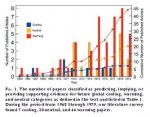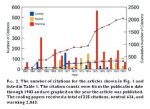So... you're quoting bits which say it's not primarily ice sheet advances which need to be feared, and that the preceding decades' cooling trend cannot continue indefinitely... and you're saying this is proof that they feared dramatic future cooling?
Did you bother to read to page 43 (67 of the pdf) - you know, the part about Man's Impact on Climate - or even just Ctrl+F for 'carbon'?
Man's Impact on Climate
While the natural variations of climate have been larger than those that may have been induced by human activities during the past century, the rapidity with which human impacts threaten to grow in the future, and increasingly to disturb the natural course of events, is a matter of concern. These impacts include man's changes of the atmospheric composition and his direct interference with factors controlling the all-important heat balance.
Carbon Dioxide and Aerosols
The relative roles of changing carbon dioxide and particle loading as factors in climatic 'change have been assessed by Mitchell (1973a, 1973b). . . .
The corresponding changes of mean atmospheric temperature due to CO2... appear capable of accounting for only a fraction of the observed warming of the earth between 1880 and 1940. They could, however, conceivably aggregate to a further warming of about 0.5 °C between now and the end of the century. . . .
The impact of such particle loading on the mean atmospheric temperature cannot be reliably determined from present information. . . . Aerosols may also affect the structure and distribution of clouds and thereby produce effects that are more important than their direct radiative interaction (Hobbs et al., 1914; Mitchell, 1974).
Of the two forms of pollution, the carbon dioxide increase is probably the more influential at the present time in changing temperatures near the earth's surface (Mitchell, 1973a).
Clearly in 1975 (as in 2013) it was recognised that aerosols and CO2 have been the biggest areas of human climatic influence; that aerosols have a two-fold climate effect; that there's more uncertainty of aerosol influence than for CO2; but that CO2 had likely been a bigger factor.
There's obviously no dramatic cooling scare there; not even your quotes suggest one! I wonder where you found them quote-mined at, since it's so obvious that you yourself hadn't attempted even a cursory look for relevant information in the report?


